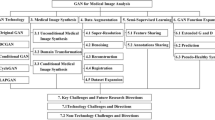Abstract
This paper focuses on the concept of generative adversarial networks (GANs) and their scope in the medical field. “Generative adversarial networks” has been one of the most prominent research areas in the domain of machine learning in the past few years. It consists of two neural networks competing against each other. One of them is a generator model which generates fake samples of data and the other is a discriminator model which receives both real data (from the training data) and fake data (from the generator model) and tries to identify them as real or fake. Use of generative adversarial networks has been done here for the purpose of “super-resolution” because GANs work on the concept of generative modeling. Since applying super-resolution to an image means adding more data to the image which was not previously there (2017), it would require generation of data which might not be actually real data but is so close to the real one that one cannot know the difference. Hence, when we apply super-resolution using generative adversarial networks it gives us way better results in comparison to many other approaches such as “SRCNN”.
Access this chapter
Tax calculation will be finalised at checkout
Purchases are for personal use only
Similar content being viewed by others
References
Galteri L, Seidenari L, Bertini M, Bimbo AD (2019) Towards real-time image enhancement GANs
Radford A, Metz L, Chintala S (2016) Unsupervised representation learning with deep convolutional generative adversarial networks
Ledig C, Theis L, Husz ́ar F, Caballero J, Cunningham A, Acosta A, Aitken A, Tejani A, Totz J, Wang Z, ShiTwitter W (2017) Photo-realistic single image super-resolution using a Generative Adversarial Network
Wang T-C, Liu M-Y, Zhu J-Y, Tao A, Kautz J, Catanzaro B (2018) High-resolution image synthesis and semantic manipulation with conditional GANs
Iqbal T, Ali H (2018) Generative adversarial network for medical images (MIGAN)
Kazeminia S, Baur C, Kuijper A, vanGinneken B, Navab N, Albarqouni S, Mukhopadhyay A (2019) GANs for medical image analysis
Liu J, Spero M, Raventos A (2017) Super-resolution on image and video
Ramavat K, Joshi M, Swadas PB (2016) A survey of super resolution techniques
Naik S, Patel N (2013) Single image super resolution in spatial and wavelet domain
Takano N, Alaghband G (2019) SRGAN: training dataset matters
Kovalenko B (2017) Super resolution with generative adversarial networks
Goodfellow I (2017) NIPS 2016 tutorial: Generative adversarial networks
Guibas JT, Virdi TS, Li PS (2018) Synthetic medical images from dual generative adversarial networks
Che Z, Cheng Y, Zhai S, Sun Z, Liu Y (2017) Boosting deep learning risk prediction with generative adversarial networks for electronic health records
Brownlee J (2019) 18 impressive applications of generative adversarial networks (GANs)
Mwiti D (2018) Introduction to generative adversarial networks (GANs): types, and applications, and implementation
Hui J (2018) GAN—super resolution GAN (SRGAN)
Thomas C (2019) Deep learning based super resolution, without using a GAN
Birla D (2018) Single image super resolution using GANs—Keras
Brownlee J (2019) How to develop a conditional GAN (cGAN) From scratch
Nayak M (2018) Deep convolutional generative adversarial networks (DCGANs)
Wang X, Yu K, Wu S, Gu J, Liu Y, Dong C, Loy CC, Qiao Y, Tang X (2018) ESRGAN: enhanced super-resolution generative adversarial networks
Author information
Authors and Affiliations
Corresponding author
Editor information
Editors and Affiliations
Rights and permissions
Copyright information
© 2022 The Author(s), under exclusive license to Springer Nature Singapore Pte Ltd.
About this paper
Cite this paper
Kant, M., Chaurasia, S., Sharma, H. (2022). Contribution Analysis of Scope of SRGAN in the Medical Field. In: Nanda, P., Verma, V.K., Srivastava, S., Gupta, R.K., Mazumdar, A.P. (eds) Data Engineering for Smart Systems. Lecture Notes in Networks and Systems, vol 238. Springer, Singapore. https://doi.org/10.1007/978-981-16-2641-8_33
Download citation
DOI: https://doi.org/10.1007/978-981-16-2641-8_33
Published:
Publisher Name: Springer, Singapore
Print ISBN: 978-981-16-2640-1
Online ISBN: 978-981-16-2641-8
eBook Packages: Intelligent Technologies and RoboticsIntelligent Technologies and Robotics (R0)




